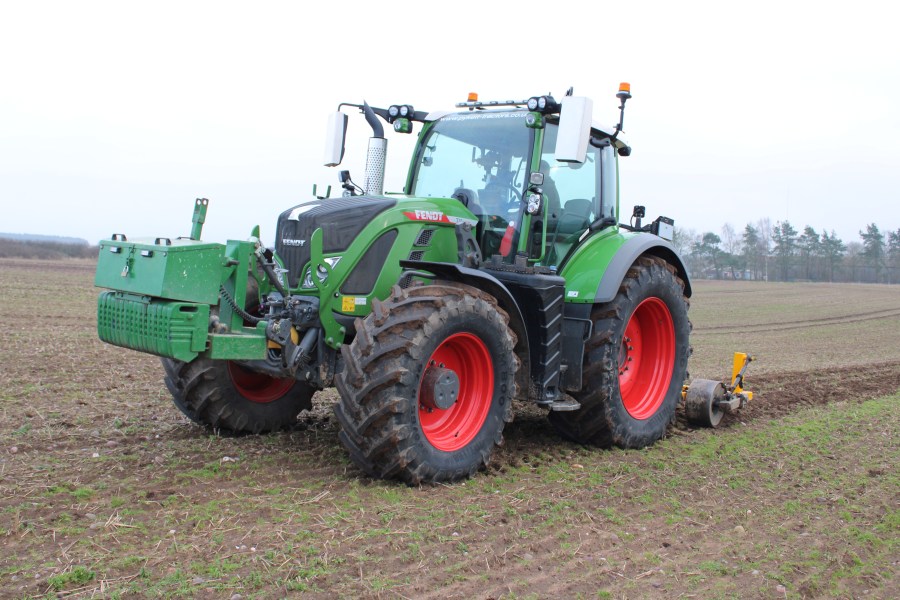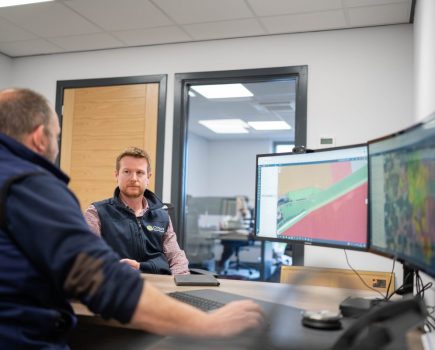Utilising data from a Fendt tractor fleet is helping an arable and root crop grower to improve operational efficiencies. CPM discovers how using the FendtOne onboard and offboard software is challenging convention.
“We’ve been able to accurately record tractor and operator performance across different crops.” ADAM HENTON
By Melanie Jenkins
Nottinghamshire-based Robert Thomas Farms has embraced the technology of FendtOne onboard and offboard systems to streamline operations, optimise tractor use and increase customer communications.
Operating four gen 6 Fendt 700 Vario tractors which all run on the FendtOne onboard system, the farm also uses FendtOne offboard – an office-based software package that’s fed data from the fleet and can create tasks to control operating costs.
Tractor operator Adam Henton manages the tasks sent to the fleet and is increasingly using data available through the technology.
“Using FendtOne offboard I’ve been able to create and log tasks for each tractor in the fleet. The data collected during that task is fed back to me and I can produce reports and evaluate the efficiency of the tractor’s hours against the task,” he explains.
The 650ha farming enterprise includes cereals, carrots and sugar beet, plus land in stewardship, horse paddocks, a herd of outdoor reared pigs and 20ha of potatoes.
“The carrot crop makes up the bulk of our turnover and requires the most hours to cultivate and manage. We don’t operate controlled traffic, but we’ve used FendtOne to improve our field mapping, boundaries and A-B lines,” he adds.
Adam says it’s the accuracy of this data that’s impressed the farm, which has used other systems in the past with varying degrees of success. “By remapping fields with FendtOne and exporting the data to the offboard system, we’ve been able to accurately record tractor and operator performance across different crops. In future years we can use this data as a benchmark and improve how we operate and reduce our costs.”
The farm contract hires its fleet from Pyketts Tractors and in doing so, has a fixed cost to use as the basis for its calculations of tractor efficiency. “Every hour affects our bottom line and using FendtOne we’re able to see how idling hours, fuel economy and operating time are all having an effect on margin.
“The aim is to only have tractors working for the time that we require them in the field, and to choose cultivation methods that minimise hours to make best use of all the farm’s machinery,” he comments.
Adam has started to compare cultivation techniques by creating tasks and sending them to his tractors which feedback the time and fuel use and enable him to calculate which is more efficient. “I can analyse how a field that’s ploughed and pressed compares with the use of a subsoiler.
“There’s a case for both depending on soil type and the crop we’re planting, but instead of repeating methods because it’s what we’ve always done, we’re now making decisions based on crop yield and cultivation cost,” explains Adam.
A key task for the FendtOne data has been to identify operational efficiencies for crops, he highlights. To do this, the farm has been using task information to choose cultivation techniques based on the soil type and crop variety.
“The data from the tractors won’t change the necessity to carry out multiple cultivation methods, but it does demonstrate to us the hard costs involved in growing particular varieties.”
Tractor data allows for the removal of headlands and other areas that aren’t cropped, which has reduced the amount of straw being bought in (for the carrot crop) and provided a saving. “And it isn’t just straw; we’re saving on polythene too by using more accurate data on how much of the field is cropped, rather than just using the total area.
“Additionally, using satellite connectivity we can start anywhere in the field where the ground is best to plant and then move outwards. If we have to stop because the weather turns, we know that any tractor or operator can go back to that field and marry up to where the first tractor started, reducing idling time,” he says.
It’s this sharing of data that enabled the fleet to operate more efficiently. With one Fendt 724 Vario and three 720 Vario tractors there’s demand for the more powerful 724 for a variety of applications. “The 724 is better suited to the HEVA seven-leg subsoiler so we want to make sure it’s available to do that work. Using data from the whole fleet I can create tasks in FendtOne offboard that prioritise where the 724 goes each day and make best use of its extra horsepower,” adds Adam.
And tractor telemetry data is improving the accuracy of ridging the carrots by making the spacing more precise, which has helped with laying the polyethene, he suggests. “With the Fendt system we’ve become accurate to the centimetre, and this has improved laying the poly which historically would blow away if the spacing was too wide.”
All four tractors average 1500 hours a year with each hour of work being recorded through individual tasks that can be cross referenced. “We’ve broken the farm down into smaller areas of between 20ha and 40ha so we don’t require larger machinery.”
The farm now chooses tractors based on the hire cost and the efficiency of each task. “We must have four tractors to manage the carrot crop, the challenge is knowing how much horsepower to deploy to which task to optimise fuel and time,” he stresses.
This extends to the contract farming the business operates locally too. Adam says when costing a job for another farm, he uses data from previous tasks to give accurate quotes, with the option to produce reports for customers.
“We map every field we contract farm with the Fendt system rather than go off the farm’s historic data. This gives us an accurate field boundary and area, but it also forms the basis of the task I create so that once the job is complete, we can show the customer the time, seed and fuel used,” he explains.
According to Adam, by operating in this way, both the farm and its customers are working with hard facts and data which can be interpreted to make savings. “For example, if we’re drilling grass seed we can map the boundary and report that to the customer. We then record seed used, including overlaps, to accurately charge for the work.
“When the job is complete it can output a PDF that shows the effective and ineffective total distance and time, along with the date, start and finish time and the implements used,” he says.
This enables the farm to take the overhead contract hire cost of the tractor, the cost of the operator, the machinery being used and the cost of any seed or product used per hectare and calculate the margin. “The verification of work is important to build better relationships – we want to be transparent and exact in our work.”
Adam highlights that since operating the Fendt fleet and FendtOne, the farm has remapped all of its fields and found that previous field boundary data held was incorrect.
“We’re also working closely with the team at Pyketts, who are monitoring the movements of every tractor remotely to manage when servicing is required. This means we can plan ahead for when a tractor is at the dealer and make sure we have sufficient machines during that time.”
This article was taken from the latest issue of CPM. Read the article in full here.
For more articles like this, subscribe here.
Sign up for Crop Production Magazine’s FREE e-newsletter here.




